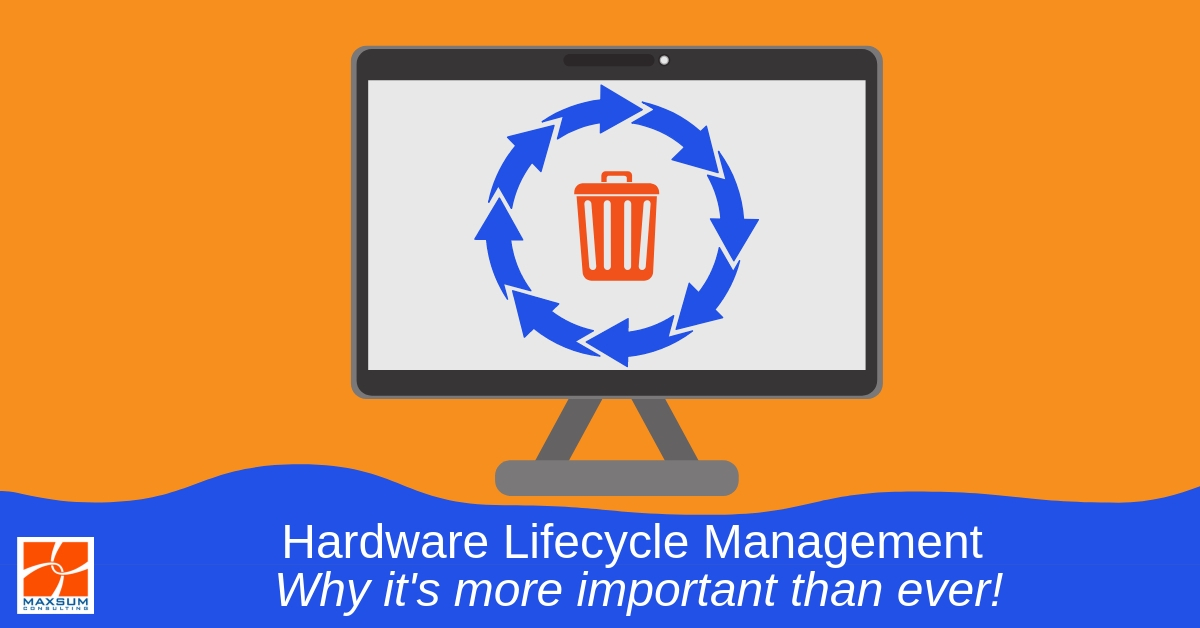How tightening up your approach across the 5 stages of your hardware lifecycle will help your business protect your assets and manage change better!
At a security event recently, we asked the 250 delegates in the room to get their phones out and stand up. They were excited; they thought they were going to get to try out some cool new app. But instead we asked them to unlock their phones and hand it over to the person across the table from them! Enter nervous laughter – a LOT of nervous laughter – What’s that? You don’t want to give a perfect stranger access to all the data on your device?
Now zoom out and think bigger picture. Think about ALL the hardware and devices that are in use across your business (as well as all the old stuff sitting in drawers and storerooms). How much of your sensitive data is still sitting on it; how old is that data; whose data is it?
Factor in regulations like the NDB Scheme, which requires Australian businesses to investigate even suspected data breaches and you should be starting to feel a bit uneasy about that old hardware and what you’re doing with it, right?
And just as you thought moving to the cloud meant you need less hardware, emerging technologies like IoT mean that in the future your business is actually likely to be using LOTS more data-enabled devices – just different once (75 billion globally by 2025 in fact!)
So, if you don’t have a clear handle on how and when hardware comes into your business, how and what you store on it, and even more importantly, how and where you’re going to dispose of it – you need a hardware lifecycle plan!
What is a hardware lifecycle plan?
A hardware lifecycle plan is a documented plan for how your organisation intends to purchase, deploy, maintain, upgrade and decommission hardware.
Why is having a plan important for your business?
Simply put, having a hardware lifecycle plan gives your organisation a tool to help you monitor and manage the usage of your IT infrastructure and mitigate potential system failure, cyber incidents or downtime risks. Having a plan can ensure organisations make more agile hardware decisions within a defined framework and can support your business through infrastructure changes.
A robust, well-planned and regularly revisited hardware lifecycle plan will:
- promote responsible and effective hardware resource allocation and management;
- help direct your organisation though periods of change;
- ensure your hardware is given the secure end-of-life treatment your organisation deserves!
Ok! I’m in! What’s next?
Planning to plan!
Not only do organisations need to develop a plan, they need to plan for the plan!
Organisations should consider their current and future needs and examine if the way they manage hardware currently is compliant, secure and future scalable.
Are you expecting growth?
- You’ll need enterprise-grade, fit-for-purpose infrastructure to support it!
Do you operate in an industry that’s statistically more likely to suffer a data breach? Does your hardware need a major overhaul to support the best-in-class security solutions you need?
- Examine ways to minimise the risk of security and cyber incidents across the whole hardware lifecycle from the outset.
Planning to leverage more cloud-based and as-a-service offerings?
- Lift-and-shift moves the cloud are not right for everyone! Map out your hardware needs realistically to support your transition to hybrid or full cloud.
Will you actually need to look at adding new and different types of hardware going forward?
- Definitely something to consider if you’re starting to think about the potential of IoT and data capture technologies for your business.
Once you’ve reviewed the role of hardware in your business and identified how you need to manage, secure, upgrade or eliminate hardware , you’re ready to you build out your plan.
A Hardware Lifecycle Plan – The 5 Stages
Your hardware lifecycle plan needs to define your organisation’s approach to hardware across the following 5 stages.

Stage 1: Procurement and purchasing
First, document out some guidelines for how you are going to select the right hardware for your business needs! For example,
- Who are your preferred suppliers and brands?
- How are you going to procure new hardware?
- What specifications are right for your needs?
Need some tips? Watch our Maxsum Play video on How to choose the right device.
Confused about the difference between Consumer and Business Grade technology? Watch our Maxsum Play episode on that too! (With bonus insider advice on warranties and after-sales support!)
Stage 2: Deployment and installation
Once you’ve sourced your new hardware, you’ll need to think about how many people and what other services any new deployment or installation will affect and how? This is where you need to ensure you have a project plan that guides how any rollout of new hardware is conducted to minimise disruption and downtime.
Stage 3: Usage and maintenance
Who will monitor and maintain these systems once they are in place? Ongoing engagement with your internal IT department or your managed IT services provider and regular reporting on hardware usage and health metrics is a vital part of the lifecycle. Make sure your IT team is advising you on security measures and policies to protect your hardware and the data on it!
Stage 4: Upgrade and refresh
So, you’re further down the timeline now and you’re coming up to end of warranty or feeling like your systems are no longer quite meeting your needs. Perhaps you’ve even received notice from a vendor that the hardware you use is no longer going to be supportable. This is the time to review and assess your existing systems against your current needs and growth plans. Are your systems still meeting your current needs? Will they accommodate your future needs? Are they posing a security risk to your business? If things need to change and it’s time to upgrade, then it’s time to go through the procurement, deployment and maintenance cycles again. But remember! The hardware lifecycle does not finish here!
Stage 5: Decommissioning and retirement
One of the most critical parts of the entire process is usually one of the least-thought-about parts of the hardware lifecycle for most businesses.
Leaving old hardware in storage or simply taking it to the recycle yard can have potentially crippling consequences. The data stored on servers, devices, or storage devices may be sensitive or have the potential to compromise your organisation if accessed and cause harm to your valued clients, staff, contacts and beyond – Even if you aren’t using it anymore!
Depending on where you are based, your industry sector, or the nature of your business, there may be clear regulations around the decommissioning of hardware and certified data destruction.
Do your research and find out what your legal and compliance requirements are. Maxsum recommends sourcing a certified data destruction service to destroy the information that may remain on decommissioned hardware and to request a certificate of confirmation once complete. Some data destruction services may also dispose of the hardware for you; however, if this is not the case, organisations should take steps to ensure equipment is disposed of securely and responsibly.
If you need to get your hardware house in order, talk to Maxsum today on 1300 629 786 or Contact us here to talk about better ways to manage your hardware needs across the lifecycle, AND better secure your hardware and devices with next-generation, enterprise grade MFA, MDM, and IT security solutions.

